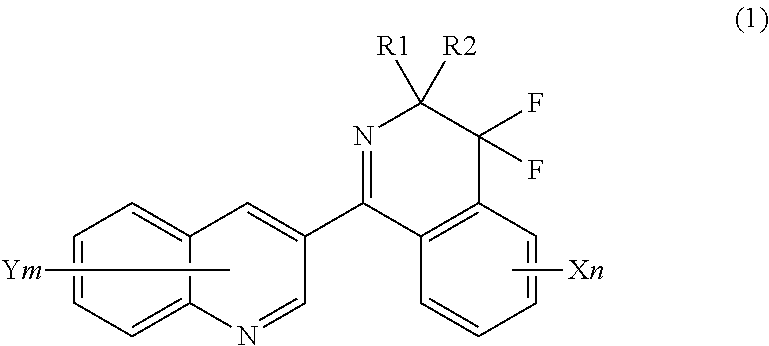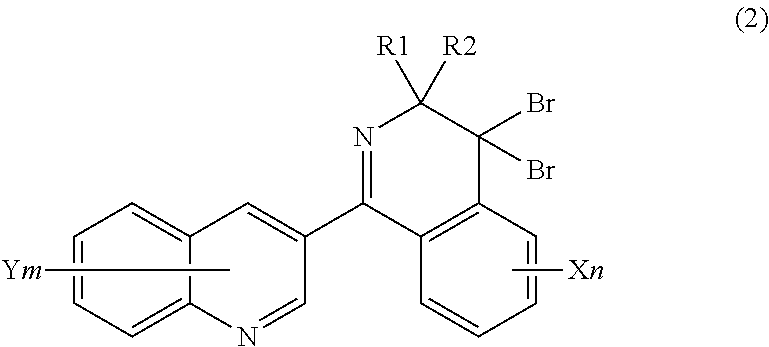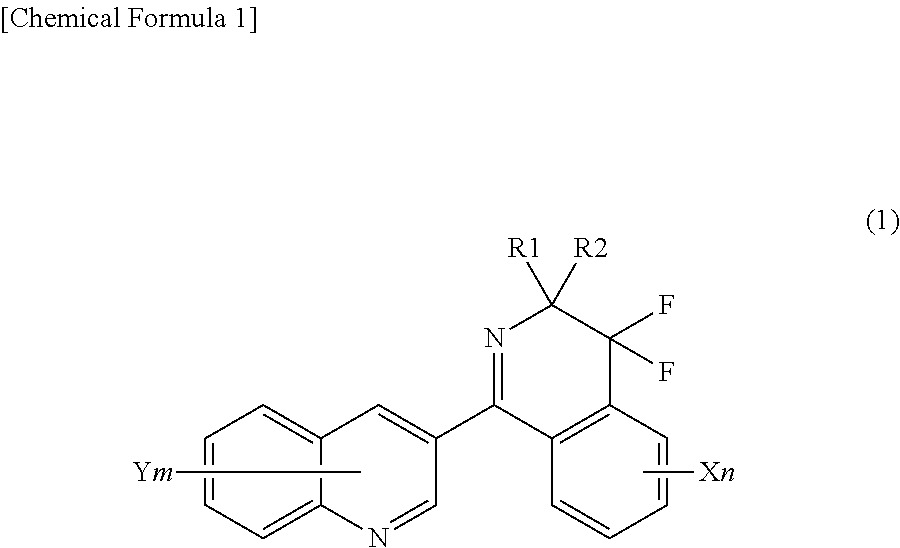Method for producing 4, 4-difluoro-3,4-dihydroisoquinoline derivatives
- Summary
- Abstract
- Description
- Claims
- Application Information
AI Technical Summary
Benefits of technology
Problems solved by technology
Method used
Image
Examples
example 1
Synthesis of Compound (II) by DBH
[0074]
[0075]4.8 g of Compound (I) were dissolved in 48 ml of chlorobenzene followed by raising the temperature to 93° C. 2.64 g of DBH and 0.42 g of 2,2′-azobis(isobutyronitrile) (AIBN) were added and stirred for 5 minutes followed by again adding 2.64 g of DBH and 0.42 g of AIBN and stirring for 2 hours. After cooling to 15° C., the mixture was stirred for 1 hour and then filtered. After distilling the filtrate under reduced pressure to remove the solvent, 5 ml of a mixture of ethyl acetate and hexane (ethyl acetate:hexane=4:1) were added to the residue followed by stirring at 15° C., further adding 15 ml of hexane and stirring for 1 hour at the same temperature. The precipitate was then filtered out to obtain 6.68 g of Compound (II) as a pale yellow solid. The purity was 94.9%.
[0076]Material Data of Compound (II):
[0077]1H-NMR (CDCl3) δ: 9.13 (1H, d, J=2.0 Hz), 8.38 (1H, d, J=2.0 Hz), 8.21 (2H, t, J=8.1 Hz), 7.89 (1H, d, J=8.3 Hz), 7.82-7.78 (1H, m)...
example 2
Synthesis of Compound (III) Using Triethylamine Trihydrofluoride
[0078]
[0079]5.0 g of Compound (II) obtained in Example 1 and 5.73 g of triethylamine trihydrofluoride were added to 30 ml of xylene and allowed to react for 4 hours at 90° C. Next, 50 g of an 18% aqueous potassium hydroxide solution were dropped in while cooling with ice followed by stirring at room temperature. After separating the liquids of the resulting reaction mixture, the organic layer was concentrated under reduced pressure. 13 ml of methanol were added to the residue, and the resulting solution was added dropwise in 50% aqueous methanol solution. 26 ml of water were additionally added followed by stirring. The resulting precipitate was filtered out to obtain 3.33 g of the title compound as a pale yellow solid. The yield was 88%, thereby demonstrating the present method to be extremely superior to the method of Comparative Example 1. In addition, the 1H-NMR data of the resulting compound coincided with that desc...
example 3
Synthesis of Compound (III) Using Triethylamine Trihydrofluoride
[0080]1.47 g of triethylamine trihydrofluoride were added to 7.5 ml of acetonitrile followed by adding 1.21 g of Compound (II) and allowing to react for 4 hours at 90° C. Measurement of the reaction mixture at this time by HPLC indicated that Compound (III) had formed in a reaction yield of 90%. After cooling to room temperature, the reaction mixture was added to an aqueous potassium hydroxide solution. Next, the resulting solution was extracted with ethyl acetate followed by drying with magnesium sulfate. After removing the magnesium sulfate, an aqueous methanol solution was added to the residue followed by stirring and filtering out the precipitate to obtain 0.67 g of Compound (III) as a pale yellow solid. Yield: 80%.
PUM
 Login to View More
Login to View More Abstract
Description
Claims
Application Information
 Login to View More
Login to View More - R&D
- Intellectual Property
- Life Sciences
- Materials
- Tech Scout
- Unparalleled Data Quality
- Higher Quality Content
- 60% Fewer Hallucinations
Browse by: Latest US Patents, China's latest patents, Technical Efficacy Thesaurus, Application Domain, Technology Topic, Popular Technical Reports.
© 2025 PatSnap. All rights reserved.Legal|Privacy policy|Modern Slavery Act Transparency Statement|Sitemap|About US| Contact US: help@patsnap.com



